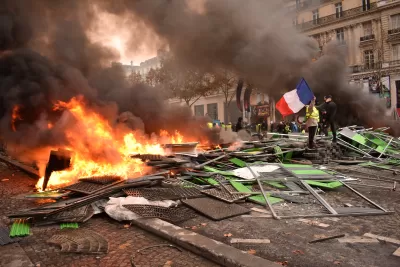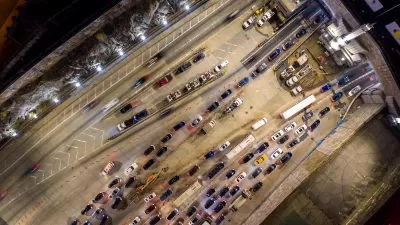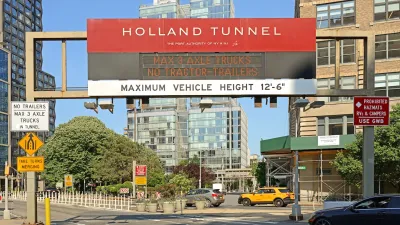Low emission zones, like that implemented in London, face backlash from critics on all sides of the political spectrum for impacting the poorest drivers and putting a burden on small businesses.

U.S. cities are beginning to consider implementing low-emission zones—areas in cities in which drivers of polluting vehicles pay extra fees or are prohibited from entering—to reduce pollution and accelerate the adoption of electric vehicles. To date, Santa Monica and Los Angeles are piloting these zones, and because of their success in European cities, more U.S. cities will be focusing on this policy option. The question is how to implement them equitably. European zones illustrate what happens when equity isn’t front and center in decision-making.
In a by-election in late June, the widely unpopular British Conservative party narrowly held onto an outer-London seat in Parliament once held by Boris Johnson that they were expected to lose. What saved them was their opposition to London Labour Party Mayor Sadiq Khan's expansion of Ultra-Low Emission Zones (ULEZ) to cover most of the city.
London's Ultra-Low Emissions Zone (ULEZ) for cars was created in 2014 by then-mayor Boris Johnson. It coincides with the world’s first congestion-pricing zone that charges vehicles for entering central London during peak traffic hours. Building the ULEZ in central London made great sense. Vehicles entering the ULEZ that do not comply with stringent EU emission standards for new cars must pay a daily charge of £12.50 for smaller vehicles and £100 for heavy vehicles. The London ULEZ has been successful in reducing traffic, accidents, and nitrogen and carbon emissions. Despite that, expanding the ULEZ is proving unpopular.
Labour Mayor Khan, who succeeded Johnson, proposed the idea of expanding the zone to a much larger swath of London. The proposal makes sense to deter people from using cars to commute into central London from the city's outer boroughs, but it infuriated those who use their cars mainly to get to work and do errands within outer London—in places like Uxbridge, where the backlash against a planned expansion of the ULEZ all the way to Heathrow Airport set to take effect in August infuriated the locals and led to the Tory election upset.
Although Londoners can apply for payments to scrap or retrofit a non-compliant vehicle, ranging from £2,000 for a car, £5,000 for wheelchair-accessible vehicles, and £9,000 for small-business vans, these expanded subsidies are not enough to purchase a compliant vehicle. For people making few trips, it doesn’t pay. Many small business owners living outside the city are deciding not to do business in London, according to taxi drivers I talked to. Even Labour Party officials warned Khan that there would be backlash. Groups are vandalizing and stealing cameras installed to enforce the expanded zone.
There is a class aspect to opposition to low-emission zones and subsidies for electric vehicles and it compounds the Labour Party's longstanding deterioration among its historic base of working-class voters. ULEZ is waived for drivers who buy new low-emission cars, who tend to be affluent motorists. Nor is £12.50 a day more than chump change for well-to-do drivers who prefer to keep older cars. But it's a big deal for someone who can't afford a new car, for whom £12.50 a day is half a week's food budget.
Similar zones are being used by at least 200 cities throughout Europe and some of them are facing similar opposition. France is illustrative.
Recall the “yellow vests,” (gilets jaunes) of 2018, a largely rural, car-dependent group that undertook a series of mass protests over higher gas taxes that French President Emmanuel Macron instituted as part of a larger environmental agenda. The movement quickly evolved into protests over taxes in general, the brunt of which they argued were borne by working-class people. This movement set the stage for backlash against a 2022 policy in which the French government set a timetable for establishing 43 low-emission zones (Zones à Faible Émission, or ZFE) in its most polluted cities by the end of 2025. Currently, eleven cities have them, including metropolitan (Grand) Paris. But Paris had to delay the ban on pre-2011 diesel and pre-2006 gas vehicles planned for this July until late 2024 or early 2025 because of protests.
Both conservatives and the Green Party oppose low-emission zones because they punish the poorest drivers and offer no alternatives in places with limited public transit. As in London, critics point out that a person with a little-used older car has to pay while someone owning a new performance car doesn’t. And in some cities, the ban could have the unintended effect of contributing to the abandonment of central cities for suburban shopping areas with no bans and free parking.
Now the French Senate is likely to vote to slow the adoption of low-emission zones. But something must be done to reduce air pollution: France has been fined twice, totaling 30 million Euros, by the French Council of State for not taking sufficient action to reduce it.
In other parts of Europe, reactions to low-emission zones are mixed. In Spain, Greenpeace has led marches to pressure mayors to enact low-emission zones, but the ultra-right that dominates in so many places opposes them. In Germany, some cities are planning on removing their zones because, after 14 years, pollution is down and most people have purchased less-polluting and either fuel-efficient or electric vehicles. Environmental groups are critical of proposals to remove low-emission zones.
Addressing climate change and improving public health require urgent action on transportation carbon emissions and pollution. Low-emission zones might have their place, but they need to be implemented with complementary policies—ensuring adequate public transportation, safe bike lanes, and fair subsidies for purchasing compliant vehicles. Otherwise, they are unjust and lose necessary political support.

Alabama: Trump Terminates Settlements for Black Communities Harmed By Raw Sewage
Trump deemed the landmark civil rights agreement “illegal DEI and environmental justice policy.”

Planetizen Federal Action Tracker
A weekly monitor of how Trump’s orders and actions are impacting planners and planning in America.

The 120 Year Old Tiny Home Villages That Sheltered San Francisco’s Earthquake Refugees
More than a century ago, San Francisco mobilized to house thousands of residents displaced by the 1906 earthquake. Could their strategy offer a model for the present?

LA’s Tree Emergency Goes Beyond Vandalism
After a vandal destroyed dozens of downtown LA trees, Mayor Karen Bass vowed to replace them. Days later, she slashed the city’s tree budget.

Sacramento Leads Nation With Bus-Mounted Bike Lane Enforcement Cameras
The city is the first to use its bus-mounted traffic enforcement system to cite drivers who park or drive in bike lanes.

Seattle Voters Approve Social Housing Referendum
Voters approved a corporate tax to fund the city’s housing authority despite an opposition campaign funded by Amazon and Microsoft.
Urban Design for Planners 1: Software Tools
This six-course series explores essential urban design concepts using open source software and equips planners with the tools they need to participate fully in the urban design process.
Planning for Universal Design
Learn the tools for implementing Universal Design in planning regulations.
Ada County Highway District
Clanton & Associates, Inc.
Jessamine County Fiscal Court
Institute for Housing and Urban Development Studies (IHS)
City of Grandview
Harvard GSD Executive Education
Toledo-Lucas County Plan Commissions
Salt Lake City
NYU Wagner Graduate School of Public Service






























